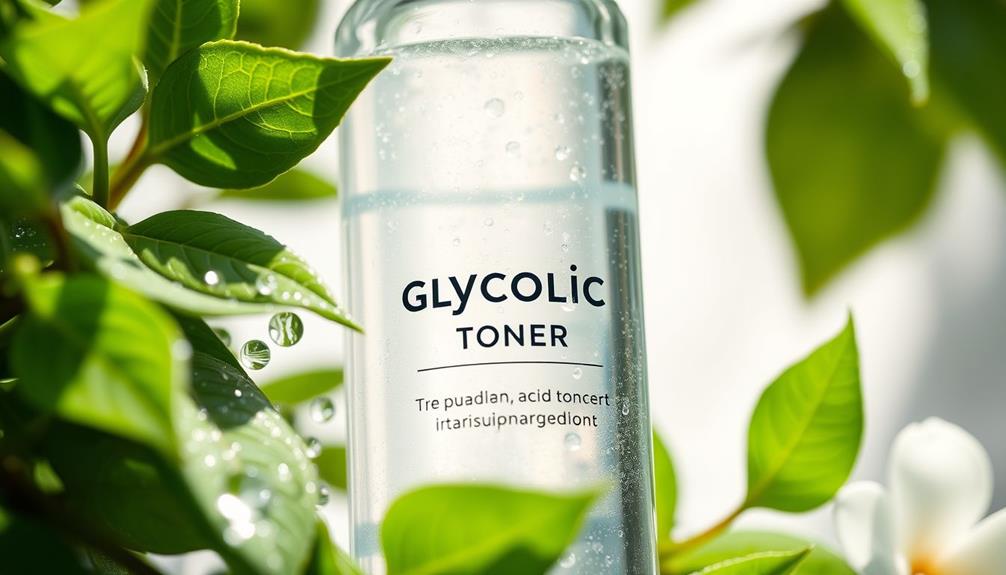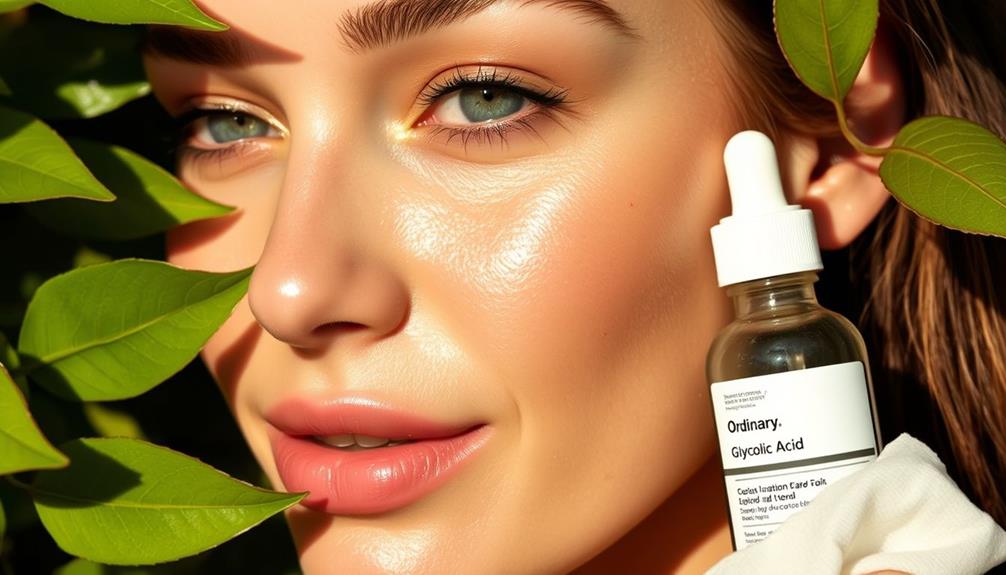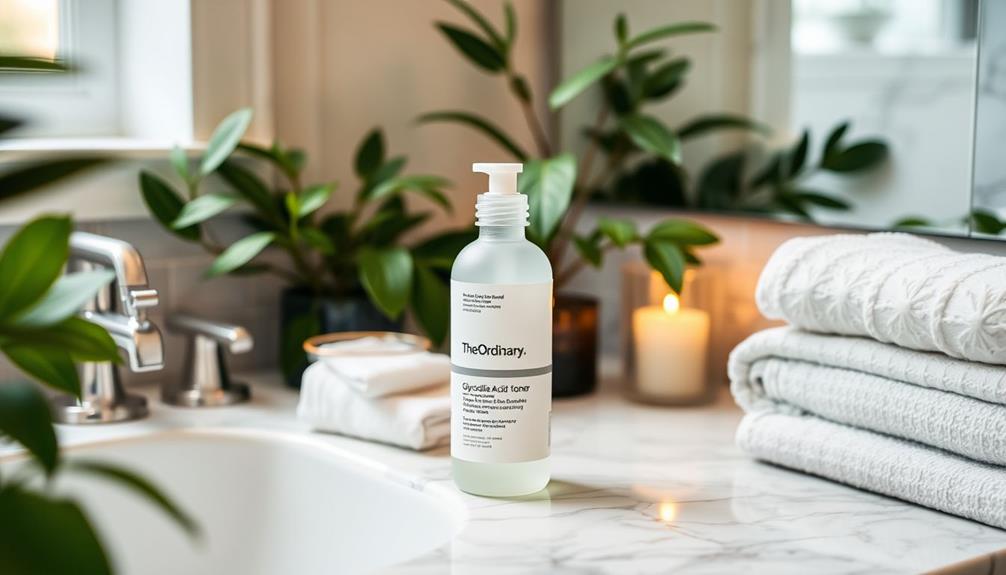A glycolic acid peel can help you achieve radiant skin by effectively exfoliating and revealing a smoother texture and brighter complexion over time. Derived from sugarcane, this alpha-hydroxy acid penetrates deeply to reduce hyperpigmentation, fine lines, and enlarged pores. You have the option of professional treatments for faster results or at-home peels for a more gradual glow. Remember to follow application guidelines and aftercare to minimize side effects. Interested in learning more about the benefits and how to begin this treatment? Click here to explore further.
Key Takeaways
- Glycolic acid peels promote exfoliation, removing dead skin cells for a smoother, more radiant complexion.
- Regular use can significantly improve skin texture, reducing fine lines and hyperpigmentation.
- The small molecular size of glycolic acid allows deep penetration, enhancing collagen production and skin elasticity.
- Light to medium peels can be done every 2-6 weeks for optimal results without extended downtime.
Understanding Glycolic Acid

Glycolic Acid, an alpha-hydroxy acid derived from sugarcane, penetrates your skin deeply and effectively thanks to its small molecular size. This unique property makes it a popular choice for chemical peels, as it dissolves the bonds between dead skin cells, promoting exfoliation. By doing so, glycolic acid helps improve your overall skin texture, leaving it smoother and more radiant.
Additionally, incorporating essential oils into your skincare routine, like Lavender for calming effects, can further enhance your skin's appearance and support overall well-being.
If you struggle with skin concerns like hyperpigmentation, fine lines, or wrinkles, glycolic acid can be beneficial. Its ability to enhance cell turnover means that it not only diminishes the appearance of these issues but also helps to prevent them from returning. This accelerated cell turnover can also reduce the visibility of enlarged pores, making your skin look more refined.
However, if you have sensitive skin, it's important to choose the appropriate concentration of glycolic acid. Lower concentrations are typically gentler and can still provide significant benefits without causing irritation.
Benefits of Glycolic Acid Peels

Experiencing the benefits of glycolic acid peels can elevate your skincare routine, delivering noticeable improvements in skin texture and radiance.
One of the most significant advantages is their ability to stimulate collagen production, which reduces fine lines and promotes a smoother skin texture. Additionally, incorporating essential oils like lavender or chamomile can enhance your skincare experience, offering essential oil blends for relaxation that complement the rejuvenating effects of glycolic acid. After just a few applications of Glycolic Acid Peels, you may notice diminished hyperpigmentation and acne scars, enhancing your skin's overall appearance.
This chemical peel works by dissolving dead skin cells and promoting cell turnover, preventing clogged pores and managing acne, resulting in a clearer complexion. The gentle yet effective nature of glycolic acid makes it suitable for various skin types, including dry, oily, aging, and combination skin, providing a versatile skincare solution.
Regular use of Glycolic Acid Peels not only helps maintain these results but also contributes to a more youthful appearance. You'll enjoy enhanced overall skin health, making it a worthwhile addition to your regimen.
Application Process and Guidelines

To achieve the best results from your glycolic acid peel, start by thoroughly cleansing your skin to create a pristine canvas. This step is vital, as it removes impurities and prepares your skin for the application process. Incorporating mindful awareness during this cleansing can enhance your overall experience, similar to self-exploration through body awareness in somatic therapy.
Next, apply the Glycolic Acid Peel evenly across your face using a cotton pad, taking care to avoid sensitive areas like your eyes and mouth. Depending on your skin's tolerance, leave the peel on for the recommended duration, usually between 1 to 10 minutes.
Once the time is up, it's important to neutralize the peel. Rinse with cool water to halt the acid's action and remove any residue. After rinsing, follow up with a gentle moisturizer to hydrate your skin, which may be more sensitive after the treatment.
Don't forget to apply sunscreen to protect your newly exposed skin from UV damage. For best results, consider a treatment schedule of one peel per month, aiming for a total of 8-10 peels over time. This approach will help you achieve and maintain radiant skin while ensuring your sensitive skin remains protected.
Side Effects and Skin Sensitivity
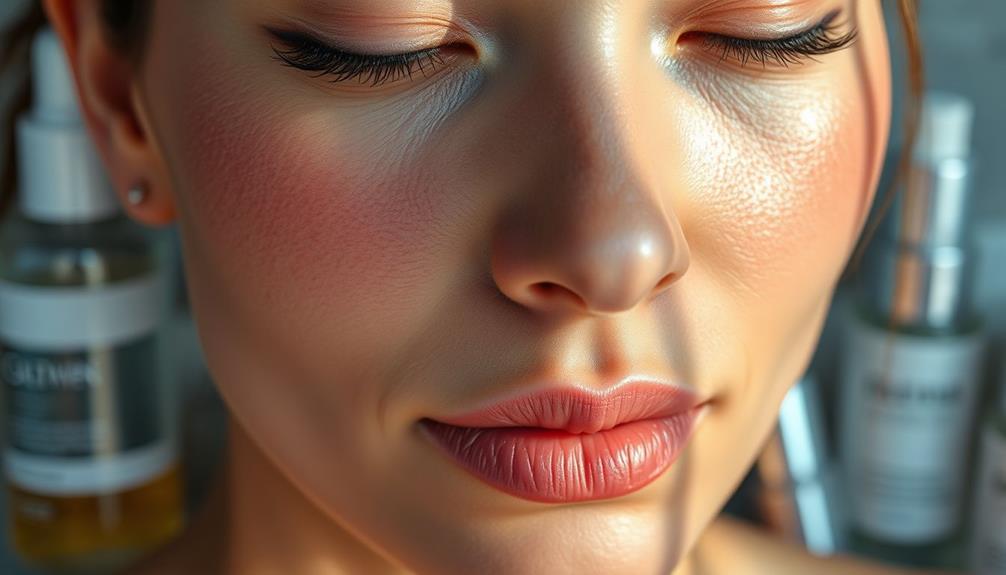
Using glycolic acid peels can lead to some common side effects, including redness and increased skin sensitivity, especially after your first treatment. You might experience mild tingling during the application, but this reaction usually subsides quickly. However, it's vital to be aware of other potential side effects:
- Redness and Sensitivity: Your skin may feel more sensitive post-treatment, which is normal as it adjusts. This heightened sensitivity can be similar to the skin reactions some individuals experience after consuming <a target="_blank" href="https://sallyteacups.org">Rooibos tea benefits</a>, such as anti-inflammatory effects.
- Peeling and Flaking Skin: As the skin exfoliates, you might notice some peeling or flaking, particularly in the days following your peel.
- Deeper Peels Risks: If you opt for deeper peels, the risk of skin scarring and infections increases, so it's important to follow professional guidance.
- Hyperpigmentation: Individuals with darker skin tones should be cautious, as they're more susceptible to pigmentation changes.
Proper post-peel care is significant; if you neglect sun protection, you may experience prolonged sensitivity and hyperpigmentation. Always apply sunscreen to safeguard your skin after treatment and minimize adverse effects.
Aftercare and Recovery Tips

Proper aftercare is vital for ensuring your skin heals well and maintains its newfound radiance after a glycolic acid peel.
Start by avoiding sun exposure and applying a broad-spectrum sunscreen daily. This protects your freshly revealed skin from harmful UV damage and prevents hyperpigmentation.
Additionally, consider scheduling a follow-up treatment at a local salon to maintain your skin's glow, as many offer packages that can help with skin health and beauty discounts or packages often available for multiple sessions.
For effective post-peel care, opt for gentle moisturizers and steer clear of harsh products or additional exfoliation for at least a week. This allows for ideal skin healing.
Incorporating ingredients like hyaluronic acid and aloe vera can hydrate and soothe your skin, enhancing comfort during recovery.
Keep an eye on your skin for any signs of unexpected reactions. If you notice excessive redness or irritation, don't hesitate to seek professional guidance.
Following specific post-peel care instructions is essential, as they can vary based on the peel's strength and your skin's sensitivity.
Frequency of Treatments
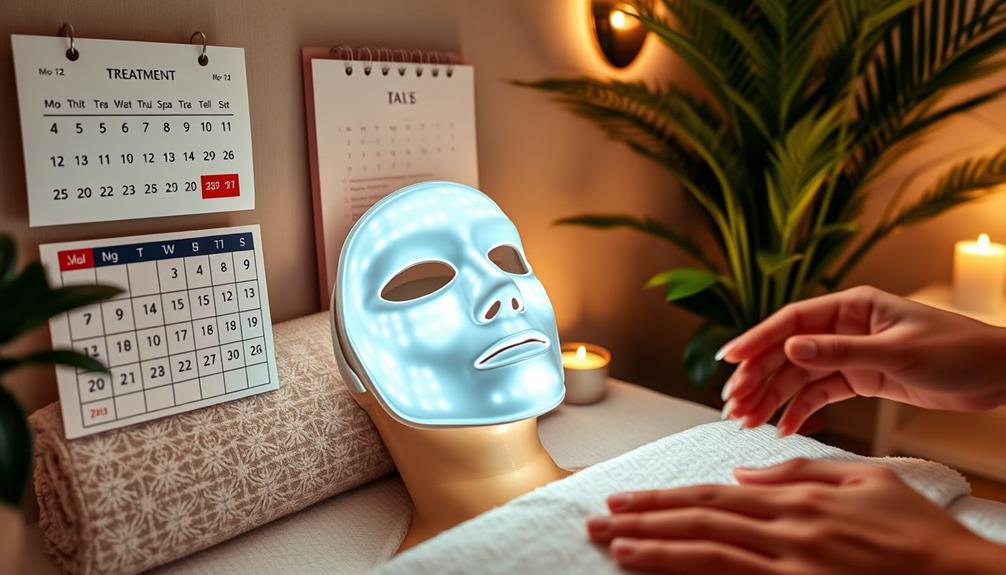
Determining the right frequency for glycolic acid peels is crucial for achieving and maintaining your skin's ideal health and glow. Regular treatments can greatly enhance your skin's texture and appearance, making it important to tailor the schedule to your specific needs.
The frequency of treatments depends on the peel's strength, your individual skin tolerance, and the desired results. Here's a quick guide:
- Light Glycolic Peels (20%-30%): You can safely perform these every 2-4 weeks. They offer minimal downtime and are great for addressing mild skin issues, such as <a target="_blank" href="https://help-zentrum.com">cold remedies</a> to boost your skin's resilience.
- Medium Peels (35%-50%): These are recommended every 4-6 weeks. They provide deeper skin renewal and texture improvement, allowing for better results while managing healing time.
- Deep Peels (55%-70%): Typically, these should be done about once a year, as they tackle severe concerns and require considerable recovery.
- Full Course: For best results, aim for a full course of 3 to 6 peels, spaced according to each peel's strength and your skin response.
Always keep an eye on how your skin reacts post-peel, and adjust the frequency of treatments as needed to guarantee you're getting the best outcomes without overdoing it.
Professional Vs. At-Home Peels
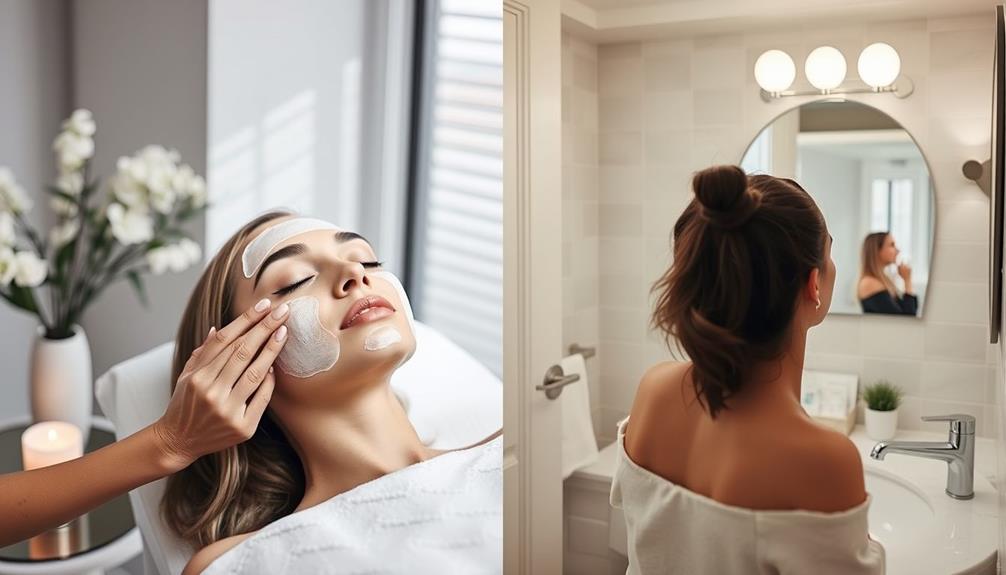
When considering glycolic acid peels, you'll often weigh the benefits of professional treatments against the convenience of at-home options.
Professional chemical peels are conducted by trained dermatologists or licensed estheticians, providing customized treatment plans that cater to your skin's specific needs. With higher concentrations of glycolic acid, these peels can yield dramatic results, including immediate skin tightening and significant reduction of pigmentation. However, they often come with downtime that can last from one to several weeks.
On the other hand, at-home peels offer a more accessible alternative. While they typically contain lower concentrations of glycolic acid, usually between 20% and 70%, they can still be effective for skin rejuvenation. You'll find that noticeable improvements require consistent use over time, but the minimal downtime allows you to resume your daily routine quickly.
Regardless of your choice, safety precautions are essential. Professional peels usually include pre-treatment consultations and personalized aftercare, while at-home users should strictly follow instructions and perform patch tests to avoid adverse reactions.
Ultimately, it's about finding the right balance between convenience and the level of results you desire for your skin.
Frequently Asked Questions
How Long Does Glycolic Acid Peel Take to Work?
Glycolic acid peels usually start showing results within 2 to 4 weeks of regular use. You might notice immediate improvements in your complexion after the first application, but full benefits require a series of treatments.
How Long Does It Take for Glycolic Acid to Show Results?
You'll typically see results from glycolic acid in one to two weeks, with improvements in texture and fine lines. For significant changes, consistency is key—aim for three to six applications for ideal results.
How Fast Does Glycolic Acid Lighten Skin?
Think of your skin as a canvas; Glycolic Acid acts like a skilled artist, gradually lightening dark spots. You'll notice improvement in just 1-2 weeks, with more significant changes after a few treatments.
What Happens to Skin After Glycolic Acid Peel?
After a glycolic acid peel, your skin undergoes natural exfoliation, revealing a smoother complexion. You might notice temporary redness, tightness, and mild peeling as your skin renews itself, so don't forget to apply sunscreen!
Conclusion
Incorporating glycolic acid peels into your skincare routine can be your shortcut to glowing skin.
By understanding its benefits and following proper guidelines, you'll reveal a fresh, radiant complexion that feels like a new beginning.
Just remember, patience is key—like a flower blooming, your skin needs time to flourish.
Whether you choose professional treatments or at-home options, you're on the path to achieving that luminous look you've always wanted.
Embrace the journey to your best skin!




